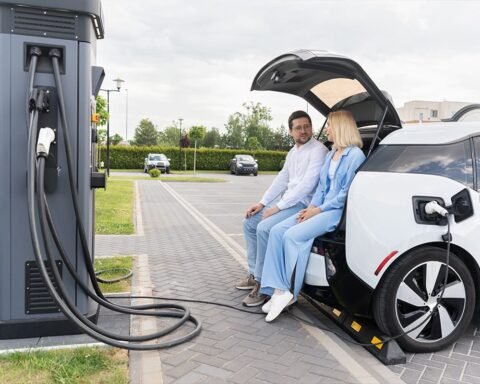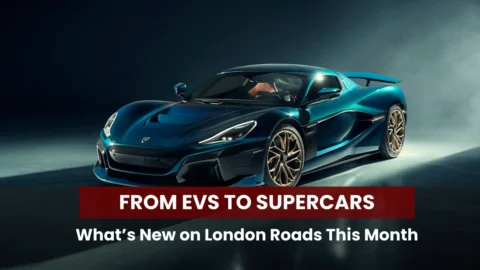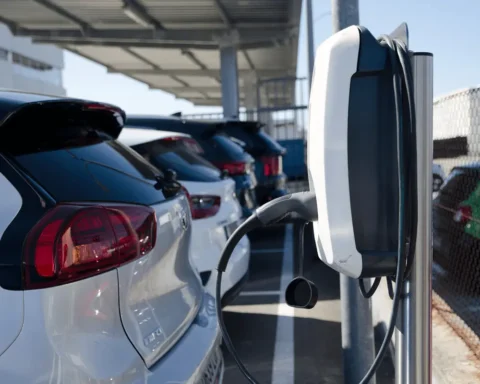EVs are breaking barriers yet again!
This time, it’s Shell that just dropped news that EV drivers will love.
Could ultra-fast electric car charging really be heading toward the “10-minute EV charge” milestone? Shell certainly would like us to believe so.
So, what exactly is Shell saying? Let’s decode the technology, assess the challenges that lie ahead, and understand why this could be a turning point in electric vehicle battery technology.
What Shell Announced: EV-Plus Thermal Fluid & Sub-10-Minute Charging
On 9 September 2025, Shell Lubricants published a press release titled “Shell EV Thermal Fluid Development Paves Way for Sub-10-Minute Charging with enhanced safety.”
Here are the headline facts:
- In collaboration with UK automotive engineering firm RML Group, Shell formulated an EV-Plus Thermal Fluid (using their Gas-to-Liquid, or GTL, technology) and tested it in a 34 kWh battery pack.
- That battery was able to charge from 10% to 80% in under 10 minutes.
- The fluid is electrically non-conductive yet fills all the spaces between battery cells (immersion cooling), giving direct contact to each cell, which helps manage heat more efficiently than traditional cooling systems.
- By reducing thermal stresses, the fluid allows much higher charging currents than current battery systems typically tolerate.
- In a hypothetical car with strong efficiency (10 km per kWh), Shell claims this could translate to ~24 km of driving range per minute of charging time.
Shell hypes this as a potential leap forward in fast EV charging, promising a balance of speed, safety, and battery health. They highlight how this kind of advanced thermal management is part of their strategy to partner with OEMs and design next-gen EV charging solutions.
How It Works: The Role of Advanced Cooling & Thermal Fluids
To understand why this is such a big deal, we need to examine how EV batteries deal with heat.
Traditional Cooling vs Immersion / Thermal Fluid Cooling
Most EVs today rely on air cooling, liquid cooling via cold plates or channels, or a hybrid approach where coolant flows along cell sides. But these approaches always have gaps. Parts of a cell’s surface may be less well-cooled, or hotspots can develop. That limits how fast you can safely charge.
Shell’s approach: an immersion cooling system. Their EV-Plus Thermal Fluid fills the tiny gaps between every cell, contacting surfaces directly, thereby allowing far better heat transfer and more uniform temperature distribution.
Because heat is one of the primary constraints on EV charging speed, managing it efficiently is critical. You can’t let one cell get too hot or risk degradation or safety failure (thermal runaway). This Shell fluid helps reduce those thermal stresses.
As Shell states, the fluid “allows batteries to tolerate much higher cell charging currents by reducing thermal stresses very significantly.”
What’s New in “Shell Thermal Fluid Innovation”
Some specific features that make it compelling:
- Non-conductive: Because it won’t cause short circuits, it can sit in direct contact with high-voltage cell components safely.
- Maximizes contact: It fills all interstitial spaces, ensuring more uniform cooling.
- Thermal stability and safety: The design aims to maintain temperature control and reduce variation within the battery pack, which helps protect against hot spots or runaway events.
- Compact battery design support: With better cooling, battery packs can be lighter or more compact, reducing complexity and cost.
In short, Shell has created the next-gen EV charging enabler, not just another tweak to the technology.
What It Means for the EV Ecosystem
Wondering what the practical implications are? Thrilling for sure, but it also calls for a bit of caution.
Speed + Convenience
A 10-minute charge for 10% to 80% dramatically narrows the advantage ICE cars have in refueling speed. If realized in production, EV charging speeds would approach parity with gas station stops for many drivers.
Infrastructure Impact
Currently, to enable high-speed charging, we need enormous power, robust cooling in chargers, expensive cable and connector tech, grid upgrades, and thermal management in battery packs. If battery packs themselves manage heat better (thanks to this fluid), it might reduce some of the demands on external infrastructure.
This could allow ultra-fast electric car charging stations to deliver more power safely, without overheating or damaging the batteries they connect to. Some experts estimate that this fluid could help enable higher power outputs without compromising safety.
OEM and Design Shifts
Car manufacturers would need to adapt battery and pack designs to support immersion cooling systems. That means redesigning cell layout, enclosure materials, sealing, pumps, fluid circuits, etc.
This could influence the entire architecture of EVs. Shell suggests this could support lighter, compact pack designs.
Battery Life & Safety Considerations
One challenge with ultra-fast charging is the stress imposed on battery cells. As the charging current goes up, internal heating increases, which can accelerate degradation. Shell’s claim is that their fluid reduces thermal stress, protecting cell integrity and lifespan.
However, real-world durability over many years and under variable environmental conditions remains to be proven.
Market Position & Strategy
This move also represents a strategic pivot for Shell, from being a fuel and charging infrastructure company toward a technology enabler. This would be Shell’s big move from petrol to battery tech.
Since Shell already supplies specialty fluids and lubricants, and they have experience in dielectric fluids, thermal fluid R&D would be the logical next step for them.
Shell’s involvement in motorsports (Formula E) is another factor that must be considered. They’re working on EV-Plus E-Thermal fluids with racing teams to refine performance under extreme conditions.
Challenges & Caveats: Why This Isn’t a Done Deal
As optimistic as this tech sounds, there are several hurdles:
- Scale & Manufacturing
Demonstrating in a 34 kWh pack is compelling, but scaling to 80 kWh+ packs that are used in long-range EVs would be a different challenge altogether.
- Cost
The fluid itself, plus system complexity (pumps, seals, fluid handling, maintenance), can add cost. That raises questions about commercial viability, especially in mid-tier EV models.
- Durability & Longevity
How will the fluid and the associated hardware perform over the years and under extreme thermal cycles, contamination, leaks, or maintenance events? That’s a question on many people’s minds.
- Integration & Retrofitting
Existing EV designs may not support immersion cooling retrofits. It will likely be easier in new, ground-up designs.
- Safety, Regulations, Certification
Any system in contact with HV (high voltage) must meet stringent safety standards. Rigorous certification and testing are required before mass deployment.
- Grid/Charger Limits
Even if battery packs can accept faster charge, the grid and charger infrastructure must catch up. Higher charger power levels, better thermal control at charging stations, robust supply lines, etc., will be needed.
Where This Tech Stands in the Broader Race
Shell isn’t the only player chasing faster charging technology. For example:
- CATL released a Shenxing Pro LFP battery boasting extremely fast charging speeds, though not quite under 10 minutes for large packs.
- EV makers and battery firms are experimenting with solid-state batteries, graphene additives, and novel chemistries to reduce internal resistance and heat.
- Thermal management itself is a hot area of research, as seen in scientific reviews on battery cooling systems.
Shell’s contribution is compelling because it works inside the battery pack, combining fluid innovation with battery pack design. It’s perhaps less flashy than an altogether new battery chemistry, but arguably more immediately impactful if proven successful.
Why This Could Be a Turning Point in EV Charging
The leap from “fast charging” (say 15-45 minutes) to sub-10-minute charging could reshape electric mobility:
- It helps reduce range anxiety, making EV use more seamless for long journeys.
- Charging stops become quicker and more convenient and closer to how we refuel gas cars.
- Battery packs might be optimized for size, weight, and cost if less buffer cooling is required.
- Charging station design could relax some cooling and thermal constraints, reducing cost and complexity.
If Shell and its partners can bring this from lab demo to production, it might be one of those breakthroughs that accelerates EV adoption visibly.
FAQ — Fast EV Charging & Shell’s Thermal Fluid
Not yet. The demonstration used a 34 kWh battery pack outside of a full production EV.
34 kWh. It’s on the lower side compared to many long-range EV packs (~60–100+ kWh).
Yes. Shell asserts the fluid is electrically non-conductive, so it can safely fill the internal spaces around battery cells.
According to Shell, around 24 km per minute (hypothetical) if the car is highly efficient (10 km/kWh).
That’s a key question that needs an answer. Shell claims the fluid reduces thermal stress and protects cell integrity under high currents, which may lessen degradation. But long-term, real-world durability is still unknown.
Shell hasn’t given a commercial timeline yet. The tech will need integration with OEM battery design, validation, certification, and cost scaling before deployment.
Yes, theoretically. The fluid helps manage heat, so battery packs may handle higher currents more safely, which complements developments in charger technology, cables, infrastructure, etc.
Closing Insights
The idea of a 10-minute EV charge is exciting, and it can no longer be considered a dream for EV owners. Shell’s thermal fluid innovation has set the ball in motion, offering a credible pathway to next-gen EV charging by addressing one of the toughest EV challenges: heat.
That said, these are early days. Demonstration packs, small-scale tests, and a few real-world trials mean we should stay cautiously optimistic. The whole process of back-and-forth between battery chemistry, adoption by manufacturers, infrastructure readiness, cost, and certification will take time and play a critical role in whether we can see this technology in EVs anytime soon.
But if this works, it’s certainly a major leap toward rapid battery charging with safety, efficiency, and durability intact.
Get the facts fast—your daily dose of car news starts with Ask About Cars.







